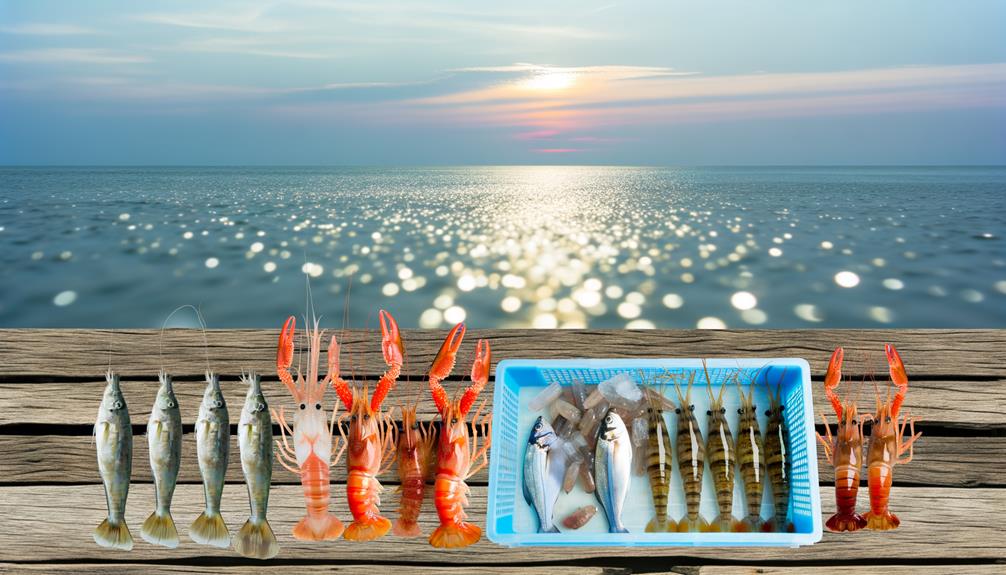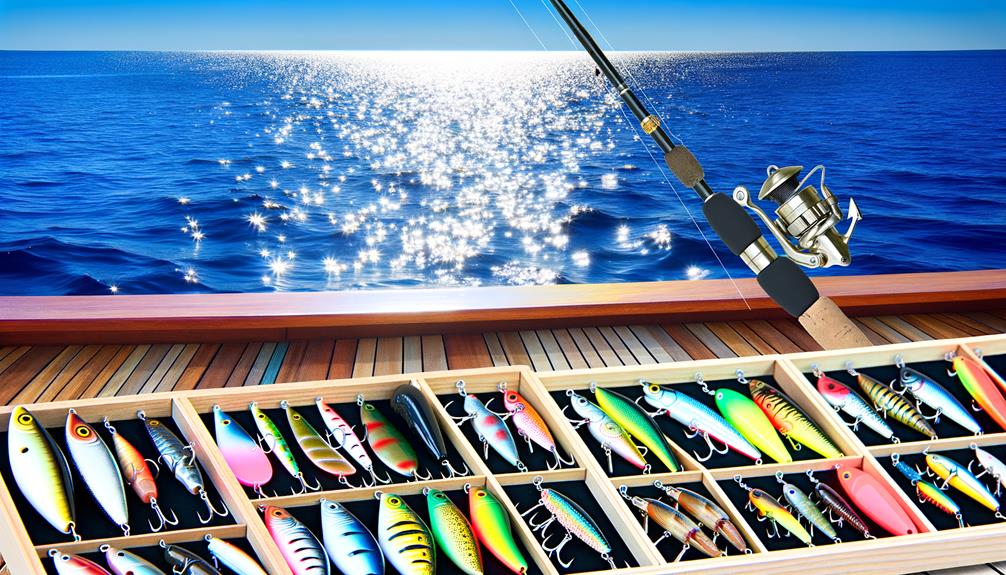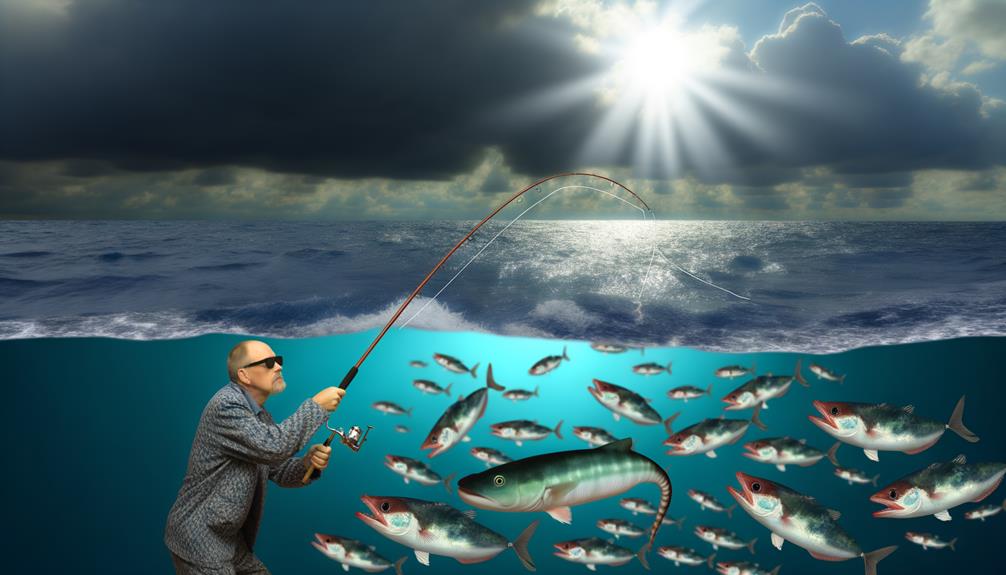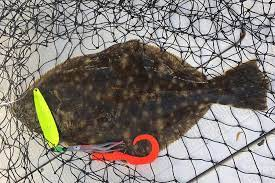The choice of bait can significantly influence the success of saltwater fishing, with options ranging from live bait to artificial lures. The effectiveness of these baits can hinge on various factors, including the target species, bait size, and fishing conditions. Live options such as shrimp or pinfish are often preferred, but the question remains – is there a universally optimal bait for all saltwater fishing scenarios?
As we explore this topic, we invite you to consider the merits of different bait types and their impact on your saltwater fishing experiences.
Key Takeaways
- The best baits for saltwater fishing include live shrimp, pilchards, mullet, pinfish, and threadfin herring.
- Bait selection should be influenced by the target fish species and their natural diet.
- Lures offer versatility and mimic injured prey, while live bait presents a more natural prey to the fish.
- Local fishing shops can provide valuable advice for the most effective bait choices specific to your fishing location.
Understanding Saltwater Bait
To maximize success in saltwater fishing, understanding the intricacies of saltwater bait selection, based on a fish’s natural diet, is crucial. The diverse ecosystem of the ocean provides a myriad of options for live bait, richer than those in freshwater environments. Saltwater fishing lures, designed to mimic these live baits, play a significant role in attracting target species effectively.
An important aspect of bait selection is size. The bait size must correspond with the target fish’s size, as this optimizes the appeal and increases the chances of a successful catch. One universally attractive option is the live shrimp, favored by a vast range of ocean fish. This versatile bait choice underscores the significance of live bait in saltwater fishing.
Moreover, catching bait can be a cost-effective alternative to buying it. Several methods, including cast nets, sabiki rigs, and traps, are popular among anglers. This not only reduces costs but also enhances the fishing experience by adding another layer of skill and knowledge. Understanding these components of saltwater bait selection is key to maximizing your success and satisfaction in this popular outdoor activity.
Selecting Bait: Factors to Consider
When selecting bait for saltwater fishing, there are several key factors to consider.
The type of bait you choose should be influenced by the specific species of fish you are targeting, as different species have different dietary preferences.
Furthermore, the size of the bait should be appropriate for the size of the fish to increase your chances of a successful catch.
Bait Types and Selection
In the realm of saltwater fishing, the correct selection of bait—a choice that hinges on various factors such as the target fish’s size and natural diet—can significantly enhance the likelihood of a successful catch. The bait types and selection process are crucial in this recreational activity. To maximize your chances of success, consider the following:
- Opt for live bait such as shrimp, pilchards, or mullet which naturally appeal to various species.
- Match the bait size to the size of the target fish.
- Reflect the fish’s natural diet in your bait choice, considering whether it prefers crustaceans or other specific types of prey.
- Live shrimp, due to its universal attractiveness, is a versatile option for many fish types.
- Seek advice from local fishing shops for the best bait selection for your target species.
Considering Fish Species
Shifting our focus to the consideration of specific fish species, it’s essential to recognize that each type has unique preferences for bait, ranging from crustaceans and bait fish to shrimp. Matching the bait to the natural diet of your target fish species can significantly boost your chances of a successful catch.
For instance, live shrimp are universally attractive to a wide range of species, marking them as an effective bait choice. A comprehensive understanding of a fish’s natural prey is crucial to bait selection. Equally important are factors like bait availability, cost, and effectiveness.
All these considerations intertwine to assist you in making an informed choice for the best bait in your saltwater fishing endeavors.
Top Live Baits for Saltwater Fishing

Among the most effective options for saltwater fishing, live baits such as shrimp, pilchards, mullet, pinfish, and threadfin herring offer distinct advantages in attracting a variety of ocean fish species. Their natural movement, scent, and color make them irresistible to fish, offering an authentic experience that artificial lures can’t match.
To help you get started on your saltwater fishing adventure, here are the top live baits that you should consider:
- Live Shrimp: Universally appealing to a plethora of ocean fish species, making them a versatile choice for any saltwater angler.
- Pilchards (White Bait/Greenies): Preferred for attracting inshore game fish, these small, shiny fish are hard to resist.
- Mullet: Found in shallow areas, they can be used alive or as cut bait, providing versatility in saltwater fishing.
- Pinfish: Easy to catch and suitable both for inshore and offshore fishing, they are effective for various saltwater species.
- Threadfin Herring: A productive option for offshore fishing, commonly used to catch pelagic species in saltwater.
Being part of the saltwater fishing community means understanding and valuing the power of live baits. Harness their allure and see the difference they make in your fishing experience.
Choosing Your Ideal Saltwater Bait
In approaching the process of selecting the perfect saltwater bait, a key consideration is the choice between live versus artificial options.
The decision is often dictated by species-specific preferences, the local availability of bait, and the seasonality of different fish species.
A comprehensive understanding of these factors will empower anglers to make well-informed choices that increase the likelihood of a successful fishing expedition.
Live Bait Selection
Choosing the ideal live bait for saltwater fishing is a critical decision that can significantly impact the success of your fishing endeavors, with factors such as the bait’s size and type playing a crucial role. While topwater lures and artificial lures can be effective, nothing beats the allure of live bait for ocean fish.
Here are some considerations when selecting live bait:
- Opt for live shrimp, a top choice due to their natural scent and movement.
- Match your bait to the fish’s natural diet to increase its effectiveness.
- Catching your own bait can be cost-effective and customizable.
- Consider the size and type of bait, as they can greatly influence your success.
- Remember that live bait attracts a wide range of fish species.
Artificial Bait Options
While live bait certainly has its merits, artificial bait options for saltwater fishing, such as soft plastic lures, spoons, plugs, and jigs, offer their own unique advantages and should not be overlooked.
Soft plastic lures, notable for their versatility, mimic natural prey, thereby attracting a variety of saltwater fish species.
Spoon lures, adept at imitating injured baitfish, can be used for both casting and trolling, offering flexibility in fishing techniques.
Plug lures create a disturbance in the water, enticing predatory fish to strike, while jigging lures are perfect for vertical fishing techniques.
You can customize these jigs with different heads for varying depths. When exploring your artificial bait options, keep in mind that the key is to experiment with different saltwater lures to find what works best for you.
Understanding Bait Seasonality
To enhance one’s success rate in saltwater fishing, it’s crucial to understand that different bait species exhibit varying levels of abundance and effectiveness during specific seasons. This concept, referred to as bait seasonality, is paramount to selecting the most attractive and available bait for target fish.
Some bait species thrive in warmer temperatures, while others are more abundant in cooler seasons.
Migratory patterns of bait species can restrict their availability during certain seasons.
Seasonal spawning periods can affect the attractiveness of certain baits.
Changes in water temperature may impact the behavior of various bait species.
Adapting your bait choice to coincide with these seasonal patterns can significantly increase your saltwater fishing success.
Essential Saltwater Fishing Lures
In the realm of saltwater fishing, several lures have proven indispensable due to their effectiveness in attracting various species at different depths and conditions. Paddletail Soft Plastic, a highly versatile lure, has become a favorite among anglers for its ability to entice predator fish at varying depths.
On the other hand, Gold Spoons, a staple in inshore tackle boxes, offer a wide array of colors and have proven successful in attracting a multitude of saltwater species. Power Prawns, mimicking shrimp, are another essential lure. Not only are they appealing to most saltwater game fish, but they are also adaptable to different fishing situations and come in a variety of colors for added attractability.
White Bucktail jigs, the classic choice, remain effective for catching species like snook, redfish, and speckled trout.
Lastly, topwater lures such as the Salt Strong Moonwalker and Heddon Zara Spook provide thrilling action and attractive movements, making them perfect for saltwater environments. These essential lures, carefully selected for their effectiveness, are an integral part of any angler’s saltwater fishing arsenal.
Best Saltwater Fishing Lures & Baits

Navigating the vast ocean of bait options for saltwater fishing can be a daunting task, yet certain baits consistently stand out for their proven effectiveness across a myriad of marine species. Whether you are engaging in inshore fishing or venturing offshore, your bait selection can significantly influence the game fish you attract.
Here are five top performers in the world of saltwater fishing baits:
- Shrimp: A versatile option, attracting a variety of fish species.
- Pilchards (White Bait/Greenies): Preferred for inshore game fish.
- Mullet: Found in shallow waters, useful as live or cut bait.
- Pinfish: Easy to catch and effective for both inshore and offshore fishing.
- Threadfin Herring: A productive choice for offshore fishing, attracting pelagic species.
Each bait has its strengths, offering unique advantages in specific fishing scenarios. Tailoring your bait to your fishing location and target species can significantly enhance your catch rates. Remember, successful saltwater fishing is not solely about selecting the best bait. It’s about employing a bait strategy that aligns with your fishing goals and adapting to the ever-changing conditions of the marine environment.
Bait Vs Lures: a Comparison
While the effectiveness of various bait types in saltwater fishing has been established, a comparative analysis between bait and lures can provide further insights into their respective advantages and limitations.
Live bait is often seen as superior due to its ability to mimic natural prey movements and scents, attracting a wide range of saltwater fish species. Conversely, lures offer reusability and versatility, with the ability to mimic injured prey. This creates erratic movements that attract predatory fish in saltwater environments.
In addition, the use of teasers and attractants with lures can enhance visibility, increase strikes, and complement lure action effectively. However, regulations often require barbless hooks and adherence to size and bag limits when using fishing lures in saltwater, affecting their overall utility.
To paint a clearer picture, let’s compare lures and live bait in a table:
| Lures | Live Bait | |
|---|---|---|
| Versatility | High | Low |
| Reusability | Yes | No |
| Regulations | Stricter | Less Strict |
| Mimicry | Injured Prey | Natural Prey |
| Attractiveness | Enhanced with Teasers | Natural Movement & Scent |
Utilizing Baitfish in Saltwater Fishing

Turning to the use of baitfish in saltwater fishing, it is worth noting that this method has gained popularity due to its effectiveness in luring a broad spectrum of predatory fish species. This approach encompasses using live baitfish, which mimic natural movements in the water, making them irresistible to many saltwater game fish.
To highlight, here are some crucial points to consider when using baitfish as a strategy in saltwater fishing:
- Baitfish such as mullet, menhaden, and sardines are commonly used due to their availability and attractiveness to predatory fish.
- The size of the baitfish should match the target fish species to increase the likelihood of a successful catch.
- Live baitfish can be rigged in different ways to optimize their presentation and appeal.
- The use of baitfish can significantly enhance the fishing experience by increasing the chances of catching a variety of fish.
- Finally, understanding the behaviors of baitfish and their predators can enhance the success rate of saltwater fishing.
Frequently Asked Questions
What Is the Best Bait for Catching Saltwater Fish?
The best bait for saltwater fishing varies, factoring in bait preservation techniques and seasonal bait preference. Live shrimp, pilchards, mullet, pinfish, and threadfin herring are commonly utilized, depending on the targeted species and environmental conditions.
What Bait Attracts the Most Fish?
To attract the most fish, consider the species’ dietary preferences, local availability, and seasonal bait choices. Using effective bait preservation techniques ensures the bait remains appetizing. Live shrimp often proves universally appealing to diverse saltwater fish.
What Is the Easiest Way to Catch Saltwater Fish?
The easiest way to catch saltwater fish involves careful Tide Timing Tips and Weather Influence Analysis. Understanding tide movements and weather patterns can significantly increase your chances of locating and catching a variety of saltwater species.
What Color Lure to Use in Saltwater?
The choice of lure color in saltwater fishing is guided by lure visibility factors and color psychology in fish. Bright colors work well in murky waters, while natural hues are effective in clear water conditions.
Conclusion
In essence, the efficacy of saltwater fishing is deeply intertwined with the selection of appropriate bait. The use of live bait, such as shrimp, pilchards, and herring, often proves successful due to its mimicry of the natural diet of many marine species.
Conversely, artificial lures present an alternative, albeit somewhat less effective. The ‘bait’ of the matter is, understanding the eating habits of targeted species and adapting one’s bait choice accordingly is paramount in saltwater fishing.





